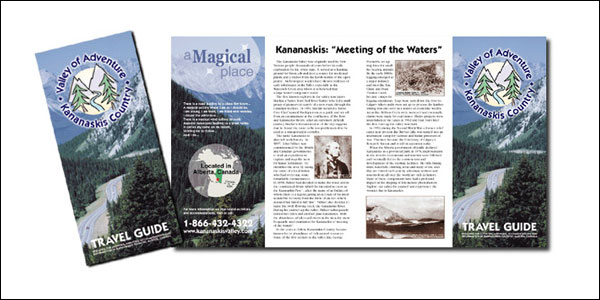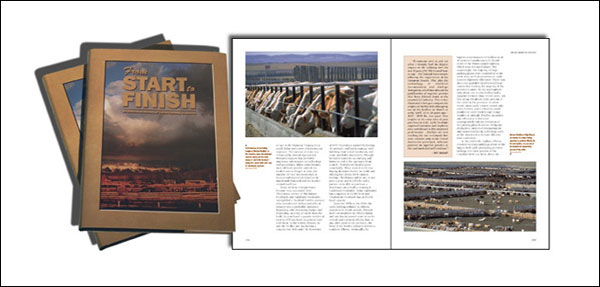Kris Nielson is a published author who has traveled throughout the province in search of archival photos and information in order to document Alberta’s history. He also has a number of printed books and magazines to his editorial credit. To read a sample of his written work, please see below. Both publications shown were also designed and produced by Kris Nielson Design.
Kananaskis Valley of Adventure Brochure
Graphic Design, Production, Research and Writing by Kris Nielson
Published by Kananaskis Valley of Adventure, Copyright © 2000
Print run: 60,000 Q, 4/4 colour, 16″ x 18″ accordian fold to 4″x9″

Kananaskis: “Meeting of the Waters” Written and researched by Kris Nielson
The Kananaskis Valley was originally used by First Nations people thousands of years before its early exploration by the white man. It served as a hunting ground for bison, elk and deer, a source for medicinal plants, and a shelter from the harsh storms of the open prairie. Archeological studies have shown evidence of early inhabitants in the Valley, especially in the Wasootch Creek area where it is believed that a large winter camp once stood.
The first known explorer in the valley was James Sinclair, a Native born Red River Settler who led a small group of pioneers in search of a new route through the Canadian Rockies. In 1854, Sinclair secured a Native Cree Chief named Mackipictoon as a guide and set off from an encampment at the confluence of the Bow and Kananaskis Rivers. After an extremely difficult journey, Sinclair’s documentation of the trip suggests that he found the route to be too problematical to be used as a transportation corridor.
The name Kananaskis is also rich with history. In 1857, John Palliser was commissioned by the British and Canadian governments to lead an expedition to explore and map the west for future settlement. He identified the area, by taking the name of a local Indian who had overcome some remarkable circumstances. In 1858, Palliser had decided to name the route across the continental divide which he intended to cross as the Kananaskis Pass “…after the name of an Indian, of whom there is a legend, giving an account of his most wonderful recovery from the blow of an axe, which stunned but failed to kill him.” Palliser also decided to name the swift flowing creek, the Kananaskis River. During his journey up the valley, Palliser subsequently named two lakes and another pass Kananaskis. With the abundance of lakes and rivers in the area, the most frequently used translation for Kananaskis is “meeting of the waters”.
In the years to follow, Kananaskis Country became known for its abundance of rich natural resources. Some of the first settlers to the valley, like George Pocaterra, set up trap lines for small fur bearing animals. By the early 1880s, logging emerged as a major industry and sites like Eau Claire and Evan-Thomas Creek became camps for logging operations. Logs were sent down the river to Calgary where mills were set up to process the lumber. Mining was also seen as a source of economic wealth. Areas like Ribbon Creek were surveyed and eventually claims were made for coal mines. Hydro projects were undertaken at the Lakes in 1932 and four years later the first road up the valley was built.
In 1939, during the Second World War, a former relief camp near present day Barrier Lake was turned into an internment camp for German and Italian prisoners-of-war. This later became the University of Calgary’s Research Station and is still in operation today.
When the Alberta government officially declared Kananaskis as a provincial park in 1978, improvements in the area for recreational and tourism soon followed and eventually led to the construction and development of the existing facilities. Ski hills, hiking trails, waterfalls, climbing areas and many of the sites that are visited each year by adventure seekers and tourists from all over the world are rich in history. Many of these components have had a profound impact in the shaping of this natural phenomenon. Explore our valley for yourself and experience the wonder that is Kananaskis.
From Start To Finish
An Illustrated History of Cattle Feeding in Alberta
Written and researched by Kris Nielson and John Prociuk
Graphic Design and Production by Kris Nielson
Published by Alberta Cattle Feeders’ Association, Copyright © 1998
Print run: 1000 Q, 9″ x 12″ hard cover with 4 colour dust jacket
216 pages, 6 8pg signatures 4/4 colour process, 21 8pg signatures 2/2 duotone
Pg 34:
One of the most notable personalities during the golden era of Alberta ranching was the legendary John Ware. While living in Idaho he was hired on as a night herder by the Northwest Cattle Company’s Tom Lynch in preparation for the Bar U’s inaugural cattle drive in 1882. Believing Ware to be an inexperienced cowboy, Lynch gave him an old nag of a horse and a seemingly befitting saddle. Soon into the drive, Ware asked Lynch for “a little better saddle and a little worse horse.” Always looking for a good laugh, the cowboys sifted through the horses and saddled up the wildest bronc of the bunch. With the poise and confidence of a seasoned veteran, Ware swung up on the unsettled steed and rode him into submission gaining immediate respect and admiration.
Ware’s integrity and unmatched work ethic eventually earned him the position of top cowhand for the Quorn Ranch before he bought his own spread on the north fork of Sheep Creek near Millarville. He started off with only nine head of cattle which carried the unusual brand of “9999”, on account that nine was his lucky number.
